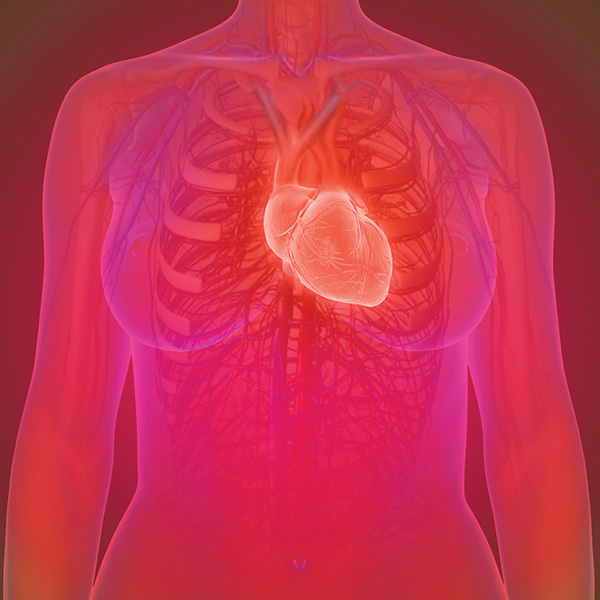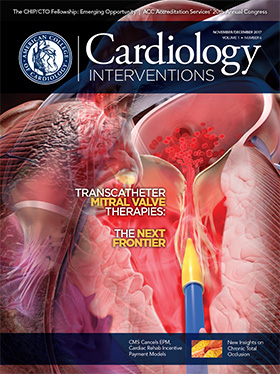Journal Wrap
The hottest research from various peer-reviewed journals.
ORBITA: First Placebo-Controlled Randomized Trial of PCI in CAD Patients
Findings from the ORBITA study presented at TCT 2017 and published in The Lancet suggest that in patients with medically treated angina and anatomically and hemodynamically severe coronary stenosis, PCI may not increase exercise time, compared with placebo. This is the first placebo-controlled randomized trial of PCI in this patient population.
"Much larger studies are needed before one could justify this approach in patients." — Kim Eagle, MD, MACC
ORBITA randomized 200 patients with severe (≥70%) single-vessel stenoses to either PCI (n = 105) or placebo (n = 95) using a blinded sham procedure where neither patients nor their physicians knew the assignment. All patients underwent cardiopulmonary exercise testing, symptom questionnaires and dobutamine stress echocardiography before and six weeks after the procedure. The primary endpoint was difference in exercise time increment between arms. Read More >>>
Overall findings showed no significant difference in the primary endpoint of exercise time increment between arms. However, PCI did significantly reduce ischemia as assessed by FFR, iFR and stress echo.
In terms of significant adverse events, researchers reported four wire complications in the placebo group requiring PCI and five major bleeding events, two in the PCI group and three in the placebo group.
“The results are consistent with the clinical experience that patients with stable angina report symptom relief after unblinded PCI,” researchers said. “ORBITA shows that this relief relies on both the true physical effect and the placebo effect.”
In a corresponding editorial, David L. Brown, MD, FACC, and Rita F. Redberg, MD, FACC, question whether the ORBITA results are the “last nail in the coffin for PCI in stable angina.” They write: “Health care providers should focus their attention on treating patients with stable coronary artery disease with optimal medical therapy, which is very effective, and on improving the lifestyle choices that represent a large proportion of modifiable cardiovascular risk, including heart-healthy diets, regular physical activity, and abstention from smoking.”
However, ACC.org Editor-in-Chief Kim Eagle, MD, MACC, urges caution before nailing the coffin shut given the very small study and no differences in hard endpoints. “Much larger studies are needed before one could justify this approach in patients. What really matters is how patients feel and how long they survive without serious complications. A much larger study to properly address those questions is badly needed in the contemporary era.”
ACC Board of Governors Chair Hadley Wilson, MD, FACC, also urges additional studies. “Even though exercise time was not significantly improved with PCI, ischemia was reduced by objective testing, which has been correlated in findings from the COURAGE nuclear substudy and other studies with improved long-term outcomes,” he said.
Al-Lamee R, Thompson D, Dehbi HM, et al. Lancet 2017;Nov 2:[Epub ahead of print].
CULPRIT-SHOCK: Culprit Lesion Only PCI Vs. Immediate Multivessel PCI in Cardiogenic Shock

Patients with multivessel coronary artery disease and acute myocardial infarction with cardiogenic shock who underwent culprit lesion only PCI had a lower 30-day risk of death or severe renal failure compared with those who had immediate multivessel PCI, said researchers presenting CULPRIT-SHOCK at TCT 2017.
The trial randomized 706 patients to either culprit lesion only PCI, with the option of staged revascularization, or immediate multivessel PCI. The primary efficacy endpoint was 30-day mortality or severe renal failure requiring renal replacement therapy. Safety endpoints included assessment of bleeding and stroke. Roughly half of enrolled patients had been resuscitated prior to randomization, 62 percent presented with STEMI and 28 percent received some form of hemodynamic support. Read More >>>
Results, also published in the New England Journal of Medicine, showed the rate of the primary composite endpoint was significantly lower in patients assigned to culprit lesion only PCI compared with immediate multivessel PCI (45.9 percent vs. 55.4 percent). There was a significant difference between study groups with respect to all-cause mortality (43.3 percent vs. 51.5 percent), while the difference in the rates of renal replacement therapy was not statistically significant (11.6 percent vs. 16.4 percent). Additionally, researchers noted no significant differences in the time to hemodynamic stabilization, length of intensive care unit stay or requirement for and duration of catecholamine therapy.
“Cardiogenic shock during myocardial infarction is a relatively rare, but extremely dangerous condition, in which the heart is unable to pump enough blood to meet the body’s needs,” says Holger Thiele, MD. “Not only is CULPRIT-SHOCK the largest randomized trial in cardiogenic shock, it is also the first randomized trial to assess a strategy of multivessel PCI versus culprit vessel only PCI with the option of staged revascularization in this patient population. Based on these 30-day results, culprit vessel only PCI reduces mortality or severe renal failure.”
In a related editorial, Judith S. Hochman, MD, FACC, and Stuart Katz, MD, FACC, note that “despite major advances in PCI technique and antithrombotic pharmacology during the approximately 20 years between the SHOCK trial and the CULPRIT-SHOCK trial, 30-day mortality among patients who underwent initial culprit-lesion only PCI was nearly identical in the two trials (approximately 45 percent).” They recommend additional trials to test strategies that may further reduce mortality.
Thiele H, Akin I, Sandri M, et al. N Engl J Med 2017;Oct 30:[Epub ahead of print].
Comparison of Conscious Sedation Versus General Anesthesia for TAVR
Transcatheter aortic valve replacement (TAVR) with conscious sedation is associated with lower in-hospital and 30-day mortality and a shorter length of stay compared with TAVR with general anesthesia, according to a recent study published in Circulation.
Matthew C. Hyman, MD, PhD, et al., used the STS/ACC TVT Registry to analyze the outcomes of 10,997 patients at 314 hospitals who underwent elective percutaneous transfermoral TAVR between April 1, 2014 and June 30, 2015. Approximately 15.8 percent (n = 10,997) were treated with conscious sedation, of whom 102 converted from conscious sedation to general anesthesia. Over the study period, the percentage of national TAVR cases performed under conscious sedation per quarter rose 9 percentage points (11 percent to 20 percent, p < 0.001), as did the number of sites utilizing conscious sedation for at least one TAVR case. Read More >>>
While intraprocedural success was similar, those who underwent TAVR with conscious sedation were less likely to suffer in-hospital (1.6 percent vs. 2.5 percent; p = 0.03) and 30-day (2.9 percent vs. 4.1 percent; p = 0.03) death than those treated with general anesthesia. Additionally, further analysis showed conscious sedation patients had a briefer ICU and hospital length of stay than general anesthesia patients. They were also more likely to be discharged directly home.
The study authors note the results “have the potential to alter the current standard of care for TAVR,” since the transition to conscious sedation “may allow TAVR cases to move from operating rooms to catheterization laboratories and improve post-procedurally recovery times.”
“The most important finding of this study is the observation that TAVR with conscious sedation can be performed safely,” they add. The data showed an adjusted lower procedural success rate of 97.9 percent, a minimal difference compared with the general anesthesia group (98.6 percent).
Researchers find these results to be “even more notable as the current study evaluated utilization of conscious sedation during its initial entry into US practice, and the outcomes for conscious sedation may improve as centers gain more experience.” Given the 30-day event rates observed in this study, the authors suggest a randomized trial with 4,776 patients to establish the superiority of one technique over the other.
Hyman MC, Vemulapalli S, Szeto Wy, et al. Circulation 2017;Sept 1:[Epub ahead of print].
Post-AMI Hospital Mortality Rates Differ by Age in NCDR Study
Outcomes for older patients who are hospitalized for acute myocardial infarction (AMI) are used by the Centers for Medicare and Medicaid Services (CMS) to calculate and publicly report hospitals’ 30-day risk-standardized mortality rates (RSMR). However, a retrospective cohort study published in Annals of Internal Medicine shows these RSMRs may not be representative of mortality rates for younger patients and may have an impact on a hospital’s overall quality improvement efforts for AMI patients.
Led by Kumar Dharmarajan, MD, MBA, et al., the study analyzed data from 968 hospitals in ACC’s ACTION Registry. They identified 543,794 adult hospitalizations between Oct. 1, 2010 and Sept. 30, 2014. When stratified by age, the total study population was split in nearly equal halves: 267,763 hospitalizations involved older patients (≥65 years) and 276,031 involved younger patients (18-64 years). The average age was 64.8 years among all patients, 76.3 years among older patients and 53.6 among younger patients. Upon admission, older patients were more likely to have acute heart failure, but less likely to have STEMI compared with younger patients (p < 0.001 each). Read More >>>
Researchers calculated mortality rates within 30 days of readmission based on age and correlated hospital AMI achievement scores for each age group by applying CMS’ Hospital Value-Based Purchasing (HVBP) Program method. Older patients had the highest median hospital 30-day RSMRs at 9.4 percent, bringing the total patient population’s RSMR up to 6.2 percent. Younger patients had a 3 percent RSMR. A similar correlation was found among resulting HVBP achievement scores; scores for older patients correlated more strongly with those for all patients (R = 0.92) than with score for younger patients (R = 0.30).
Interestingly, most of the top- and bottom-performing hospitals for older patients ranked differently for younger patients. “The assumption that the outcomes of younger patients parallel those of older patients within a hospital does not hold up,” says Jeptha Curtis, MD, one of the study co-authors.
“The lack of focus on hospital outcomes for younger patients is a missed opportunity because initial hospital quality for AMI may influence long-term mortality,” state the study authors. “Stratified reporting of quality measures with separate estimates of hospital quality for younger and older patients would permit further examination of the presence and effect of age-related differences in hospital quality.”
Dharmarajan K, McNamara RL, Wang Y, et al. Ann Intern Med 2017;167:555-64.
PROPEL: No Benefit to GM-CSF to Improve PAD Walking Performance
In patients with peripheral artery disease (PAD), supervised treadmill exercise may improve walking performance, whereas granulocyte-macrophage colony-stimulating factor (GM-CSF) either alone or in combination with exercise showed no improvement, according to results from the PROPEL trial presented at AHA 2017 and simultaneously published in the Journal of the American Medical Association.
Mary M. McDermott, MD, et al., evaluated 210 patients with PAD randomized to supervised exercise plus GM-CSF (n = 53); supervised exercise alone (n = 53); GM-CSF alone (n = 53); or attention control plus placebo (n = 51). Supervised exercise included treadmill exercise three times weekly for six months. Attention control included weekly educational lectures by clinicians for six months.
"The results confirm the benefits of exercise but do not support using GM-CSF to treat walking impairment in patients with PAD." — Mary M. McDermott, MD, et al
At 12-weeks, exercise plus GM-CSF “did not significantly improve 6-minute walk distance” more than exercise alone (mean difference, −6.3 m; p = 0.61) or more than GM-CSF alone (mean difference, +28.7 m; Hochberg-adjusted p = 0.052).
The authors conclude their results “confirm the benefits of exercise but do not support using GM-CSF to treat walking impairment in patients with PAD.”
McDermott MM, FerrucciL, Tian L, et al. JAMA 2017;Nov 15:[Epub ahead of print].
Keywords: ACC Publications, Cardiology Interventions, American Medical Association, Anesthesia, General, Angina, Stable, Cardiovascular Diseases, Catecholamines, Catheterization, Conscious Sedation, Constriction, Pathologic, Coronary Artery Disease, Coronary Stenosis, Echocardiography, Stress, Exercise, Exercise Test, Granulocyte-Macrophage Colony-Stimulating Factor, Health Personnel, Heart Failure, Hemodynamics, Hospital Mortality, Hospitalization, Intensive Care Units, Length of Stay, Macrophage Colony-Stimulating Factor, Medicaid, Medicare, Myocardial Infarction, Operating Rooms, Patient Admission, Patient Readmission, Peripheral Arterial Disease, Placebo Effect, Quality Improvement, Random Allocation, Registries, Renal Insufficiency, Renal Replacement Therapy, Retrospective Studies, Risk Factors, Shock, Shock, Cardiogenic, Smoking, Myocardial Infarction, Stroke, Standard of Care, Transcatheter Aortic Valve Replacement, Value-Based Purchasing, Walking
< Back to Listings

